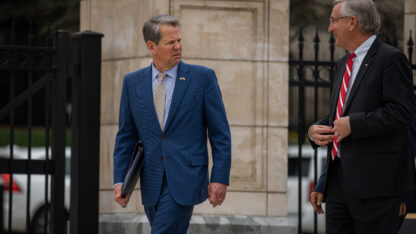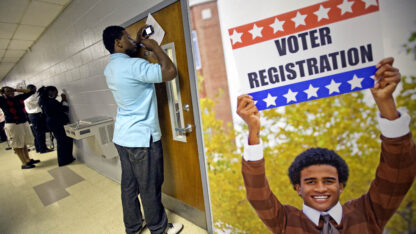Construction Begins On Spiked Fence That Will Encompass Georgia’s Capitol

Construction will begin this week at the state Capitol on an 8-foot-tall, steel fence: Complete with sharp spikes on top to deter people from climbing over.
Wikimedia Commons
Walk down Capitol Avenue this week, and you might notice workers prepping to lay down the foundation in front of Atlanta’s historic Gold Dome building.
The foundation will eventually hold up an 8-foot-tall, steel fence: Complete with sharp spikes on top to deter people from climbing over.
Following a summer of nationwide protests over racial injustice, Georgia leaders approved a deal for the fence to encompass the Capitol. It’s part of an up-to five million dollar package of security upgrades in the area.
The Georgia Building Authority, which is overseeing the project, says the fence was approved after protesters vandalized government buildings over the summer, including state police headquarters. Those protests came after mounting frustrations over police killings of Black Americans like Rayshard Brooks, Breonna Taylor and George Floyd.
Soon after protesters caused “extensive damage” to the Georgia Department of Public Safety headquarters, Gov. Brian Kemp ordered nearly a thousand National Guard troops to Atlanta to patrol Capitol grounds.
In Georgia, we stand against violence and with law enforcement. Rest assured, these criminals will be held accountable for their destructive and dangerous behavior. #gapol https://t.co/s7UZq7UJXh
— Brian Kemp (@BrianKempGA) July 5, 2020
But the destruction at DPS was enough to push state lawmakers to act, and Republican leaders quickly approved millions for the fence.
State Democrats immediately condemned the plan, saying it’s just another wedge between citizens and democracy.
State Rep. Matthew Wilson even clapped back via Twitter in October that “Republicans can build a fence around the State Capitol, but it won’t protect them from Georgia voters.”
Republicans can build a fence around the State Capitol but it won’t protect them from Georgia voters in 27 days. https://t.co/bKwZeGgpWa
— Matthew Wilson (@mwilsonGA) October 7, 2020
But Georgia Building Authority chief of staff Gerald Pilgrim said the fence would protect the state taxpayers’ assets.
“The Capitol is an asset, and protests where people try to paint graffiti on the Capitol, or take over or destroy the Capitol… it’s not going to be allowed on our property,” he said.
Pilgrim said the National Guard is currently spending 200 thousand dollars a month securing the area, and the fence would eliminate that entire cost. It’s expected to be completed in the spring.
But others believe the fence is out of touch with what Georgians truly need from their elected officials, especially during a historic pandemic and record unemployment rates.
Jonathan Lykes is a local activist with Liberation House – a group that advocates for Black, queer and trans people. He said authorities could save a lot more money by not building a useless fence.
“I think the fence in front of the state Capitol building is a physical representation of the barrier they want to put between Black and brown communities and Democracy,” Lykes said.
Funding for the fence and other security upgrades around the Capitol will come from prior sales of state surplus properties. State officials told WABE that money must go towards the support of the Georgia Building Authority, which is responsible for the grounds and buildings that make up Georgia’s Capitol Hill.
That money was also quietly approved via a GBA conference call in October, with Gov. Kemp presiding as chairman.
Lykes believes the fence is a waste of millions and feels that money could be better spent helping Georgia students, health care workers, first responders and families hit hard by the coronavirus pandemic.
“They can continue to increase security wherever they want, but that’s not fixing the issues that people are protesting about in the first place,” he said.
Lykes said he’s also no stranger to protesting near government buildings. Even before the fence was approved, Lykes described a situation outside of the Capitol that happened to him back in July.
“We were simply going to shoot and record some videos of folks vogueing, a queer dance style, in front of the Capitol,” Lykes said.
But within five minutes of their community of House and Ballroom dancers strutting for the camera, Lykes said Atlanta police rolled up and asked them to leave. Eventually, Lykes said the group ended up going across the street to film, but the damage was done.
“It just goes to show you that it’s a feeling that we don’t have access to our own systems of democracy,” Lykes said. “Not only do we not have access, but we’re not wanted at these spaces.”
CEO and president of the National Center for Civil and Human Rights Jill Savitt said the fence is not a handshake — it’s a fist. Savitt heads an institution that archives and preserves a history of protest. She broke down what it means when the government puts up a fence, or other physical barriers, in response to demonstrations.
“Things like fences, or military-style uniforms and equipment, what it does is further get the sense that government is trying for more authoritarian control, versus a democratic process.”
Savitt said events like this fence going up evoke some core moments from the civil rights movement. She recounted the story of the late Rev. C.T. Vivian, who was beaten by local county Sheriff Jim Clark on the courthouse steps in Selma, Alabama, in 1965. Vivian was trying to ensure the Black community had the right to vote. But Clark was hostile and violent in his attempt to keep the status quo in the Jim Crow South.
“Clark punched Vivian right in the face when he tried to make his case,” Savitt said.
Now, more than half a century later, advocates say the intimidation is still there — and while the fence isn’t a punch in the face, the message is clear.
But state officials say the fence isn’t keeping people out during normal business hours, and nearby Liberty Plaza will still be open from 9 a.m. to 5 p.m.
Pilgrim said the businesses of the people still need to go on in the Capitol.
“We want people to come up and enjoy the grounds, use the appropriate areas for protests,” Pilgrim assured.
Yet, in Savitt’s opinion, the government is still trying to move people further away from where policy is made.
“We see in countries that are more autocratic, that they often set aside an area for protestors, and try to constrain that space, that people can speak out,” Savitt said.
“That’s the proposition here — your speech is welcome, only in that very narrow space. Not close to the seat of power. Not close to where decisions get made.”
Christopher Alston contributed to this report.








